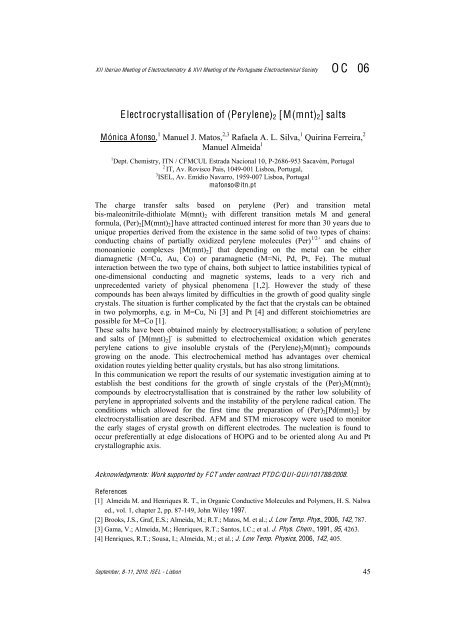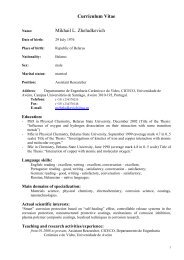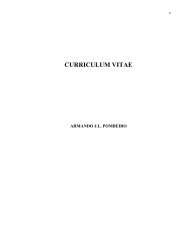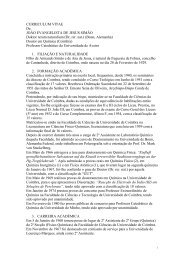XII Iberian Meeting of Electrochemistry XVI Meeting of the ...
XII Iberian Meeting of Electrochemistry XVI Meeting of the ...
XII Iberian Meeting of Electrochemistry XVI Meeting of the ...
You also want an ePaper? Increase the reach of your titles
YUMPU automatically turns print PDFs into web optimized ePapers that Google loves.
<strong>XII</strong> <strong>Iberian</strong> <strong>Meeting</strong> <strong>of</strong> <strong>Electrochemistry</strong> & <strong>XVI</strong> <strong>Meeting</strong> <strong>of</strong> <strong>the</strong> Portuguese Electrochemical Society O C 06<br />
Electrocrystallisation <strong>of</strong> (Perylene) 2 [M(mnt) 2 ] salts<br />
Mónica Afonso, 1 Manuel J. Matos, 2,3 Rafaela A. L. Silva, 1 Quirina Ferreira, 2<br />
Manuel Almeida 1<br />
1 Dept. Chemistry, ITN / CFMCUL Estrada Nacional 10, P-2686-953 Sacavém, Portugal<br />
2<br />
IT, Av. Rovisco Pais, 1049-001 Lisboa, Portugal,<br />
3 ISEL, Av. Emídio Navarro, 1959-007 Lisboa, Portugal<br />
mafonso@itn.pt<br />
The charge transfer salts based on perylene (Per) and transition metal<br />
bis-maleonitrile-dithiolate M(mnt) 2 with different transition metals M and general<br />
formula, (Per) 2 [M(mnt) 2 ] have attracted continued interest for more than 30 years due to<br />
unique properties derived from <strong>the</strong> existence in <strong>the</strong> same solid <strong>of</strong> two types <strong>of</strong> chains:<br />
conducting chains <strong>of</strong> partially oxidized perylene molecules (Per) 1/2+ and chains <strong>of</strong><br />
monoanionic complexes [M(mnt) 2 ] - that depending on <strong>the</strong> metal can be ei<strong>the</strong>r<br />
diamagnetic (M=Cu, Au, Co) or paramagnetic (M=Ni, Pd, Pt, Fe). The mutual<br />
interaction between <strong>the</strong> two type <strong>of</strong> chains, both subject to lattice instabilities typical <strong>of</strong><br />
one-dimensional conducting and magnetic systems, leads to a very rich and<br />
unprecedented variety <strong>of</strong> physical phenomena [1,2]. However <strong>the</strong> study <strong>of</strong> <strong>the</strong>se<br />
compounds has been always limited by difficulties in <strong>the</strong> growth <strong>of</strong> good quality single<br />
crystals. The situation is fur<strong>the</strong>r complicated by <strong>the</strong> fact that <strong>the</strong> crystals can be obtained<br />
in two polymorphs, e.g. in M=Cu, Ni [3] and Pt [4] and different stoichiometries are<br />
possible for M=Co [1].<br />
These salts have been obtained mainly by electrocrystallisation; a solution <strong>of</strong> perylene<br />
and salts <strong>of</strong> [M(mnt) 2 ] - is submitted to electrochemical oxidation which generates<br />
perylene cations to give insoluble crystals <strong>of</strong> <strong>the</strong> (Perylene) 2 M(mnt) 2 compounds<br />
growing on <strong>the</strong> anode. This electrochemical method has advantages over chemical<br />
oxidation routes yielding better quality crystals, but has also strong limitations.<br />
In this communication we report <strong>the</strong> results <strong>of</strong> our systematic investigation aiming at to<br />
establish <strong>the</strong> best conditions for <strong>the</strong> growth <strong>of</strong> single crystals <strong>of</strong> <strong>the</strong> (Per) 2 M(mnt) 2<br />
compounds by electrocrystallisation that is constrained by <strong>the</strong> ra<strong>the</strong>r low solubility <strong>of</strong><br />
perylene in appropriated solvents and <strong>the</strong> instability <strong>of</strong> <strong>the</strong> perylene radical cation. The<br />
conditions which allowed for <strong>the</strong> first time <strong>the</strong> preparation <strong>of</strong> (Per) 2 [Pd(mnt) 2 ] by<br />
electrocrystallisation are described. AFM and STM microscopy were used to monitor<br />
<strong>the</strong> early stages <strong>of</strong> crystal growth on different electrodes. The nucleation is found to<br />
occur preferentially at edge dislocations <strong>of</strong> HOPG and to be oriented along Au and Pt<br />
crystallographic axis.<br />
Acknowledgments: Work supported by F CT under contract PTDC/QUI-QUI/101788/2008.<br />
References<br />
[1] Almeida M. and Henriques R. T., in Organic Conductive Molecules and Polymers, H. S. Nalwa<br />
ed., vol. 1, chapter 2, pp. 87-149, John Wiley 1997.<br />
[2] Brooks, J.S., Graf, E.S.; Almeida, M.; R.T.; Matos, M. et al.; J. Low Temp. Phys., 2006, 142, 787.<br />
[3] Gama, V.; Almeida, M.; Henriques, R.T.; Santos, I.C.; et al. J. Phys. Chem., 1991, 95, 4263.<br />
[4] Henriques, R.T.; Sousa, I.; Almeida, M.; et al.; J. Low Temp. Physics, 2006, 142, 405.<br />
September, 811, 2010. ISEL - Lisbon 45








